#include <Track.h>


Public Slots | |
| void | toggleSelection () |
| void | defragment () |
Signals | |
| void | sigSamplesInserted (Kwave::Track *src, sample_index_t offset, sample_index_t length) |
| void | sigSamplesDeleted (Kwave::Track *src, sample_index_t offset, sample_index_t length) |
| void | sigSamplesModified (Kwave::Track *src, sample_index_t offset, sample_index_t length) |
| void | sigSelectionChanged (bool selected) |
Public Member Functions | |
| Track () | |
| Track (sample_index_t length, QUuid *uuid) | |
| virtual | ~Track () |
| sample_index_t | length () |
| Kwave::Writer * | openWriter (Kwave::InsertMode mode, sample_index_t left=0, sample_index_t right=0) |
| Kwave::SampleReader * | openReader (Kwave::ReaderMode mode, sample_index_t left=0, sample_index_t right=SAMPLE_INDEX_MAX) |
| Kwave::Stripe::List | stripes (sample_index_t left, sample_index_t right) |
| bool | mergeStripes (const Kwave::Stripe::List &stripes) |
| void | deleteRange (sample_index_t offset, sample_index_t length, bool make_gap=false) |
| bool | insertSpace (sample_index_t offset, sample_index_t shift) |
| bool | selected () const |
| void | select (bool select) |
| const QUuid & | uuid () const |
Protected Member Functions | |
| bool | writeSamples (Kwave::InsertMode mode, sample_index_t offset, const Kwave::SampleArray &buffer, unsigned int buf_offset, unsigned int length) |
| void | use () |
| void | release () |
Private Member Functions | |
| sample_index_t | unlockedLength () |
| void | unlockedDelete (sample_index_t offset, sample_index_t length, bool make_gap=false) |
| bool | appendAfter (Stripe *stripe, sample_index_t offset, const Kwave::SampleArray &buffer, unsigned int buf_offset, unsigned int length) |
| void | moveRight (sample_index_t offset, sample_index_t shift) |
| void | appendStripe (sample_index_t length) |
| Stripe | splitStripe (Stripe &stripe, unsigned int offset) |
| bool | mergeStripe (Kwave::Stripe &stripe) |
| void | dump () |
| Stripe * | newStripe (sample_index_t start, unsigned int length) |
Private Attributes | |
| QMutex | m_lock |
| QReadWriteLock | m_lock_usage |
| QList< Stripe > | m_stripes |
| bool | m_selected |
| QUuid | m_uuid |
Friends | |
| class | Kwave::TrackWriter |
Detailed Description
Constructor & Destructor Documentation
◆ Track() [1/2]
| Kwave::Track::Track | ( | ) |
◆ Track() [2/2]
| Kwave::Track::Track | ( | sample_index_t | length, |
| QUuid * | uuid | ||
| ) |
Constructor. Creates an empty track with a specified length.
- Parameters
-
length the length in samples uuid unique ID of the track, can be null
Definition at line 65 of file Track.cpp.
References appendStripe(), Kwave::Stripe::length(), m_stripes, Kwave::Stripe::resize(), STRIPE_LENGTH_MAXIMUM, and STRIPE_LENGTH_OPTIMAL.

◆ ~Track()
|
virtual |
Destructor.
Definition at line 79 of file Track.cpp.
References m_lock, m_lock_usage, and m_stripes.
Member Function Documentation
◆ appendAfter()
|
private |
Append samples after a given stripe.
- Parameters
-
stripe the stripe after which to instert. Null pointer is allowed, in this case a new stripe is created offset position where the new data should start buffer array with samples buf_offset offset within the buffer length number of samples to write
- Returns
- true if successful, false if failed (e.g. out of memory)
Definition at line 478 of file Track.cpp.
References Kwave::Stripe::append(), Kwave::Stripe::end(), length(), Kwave::Stripe::length(), m_stripes, Kwave::SampleArray::size(), STRIPE_LENGTH_MAXIMUM, and Kwave::toUint().
Referenced by writeSamples().
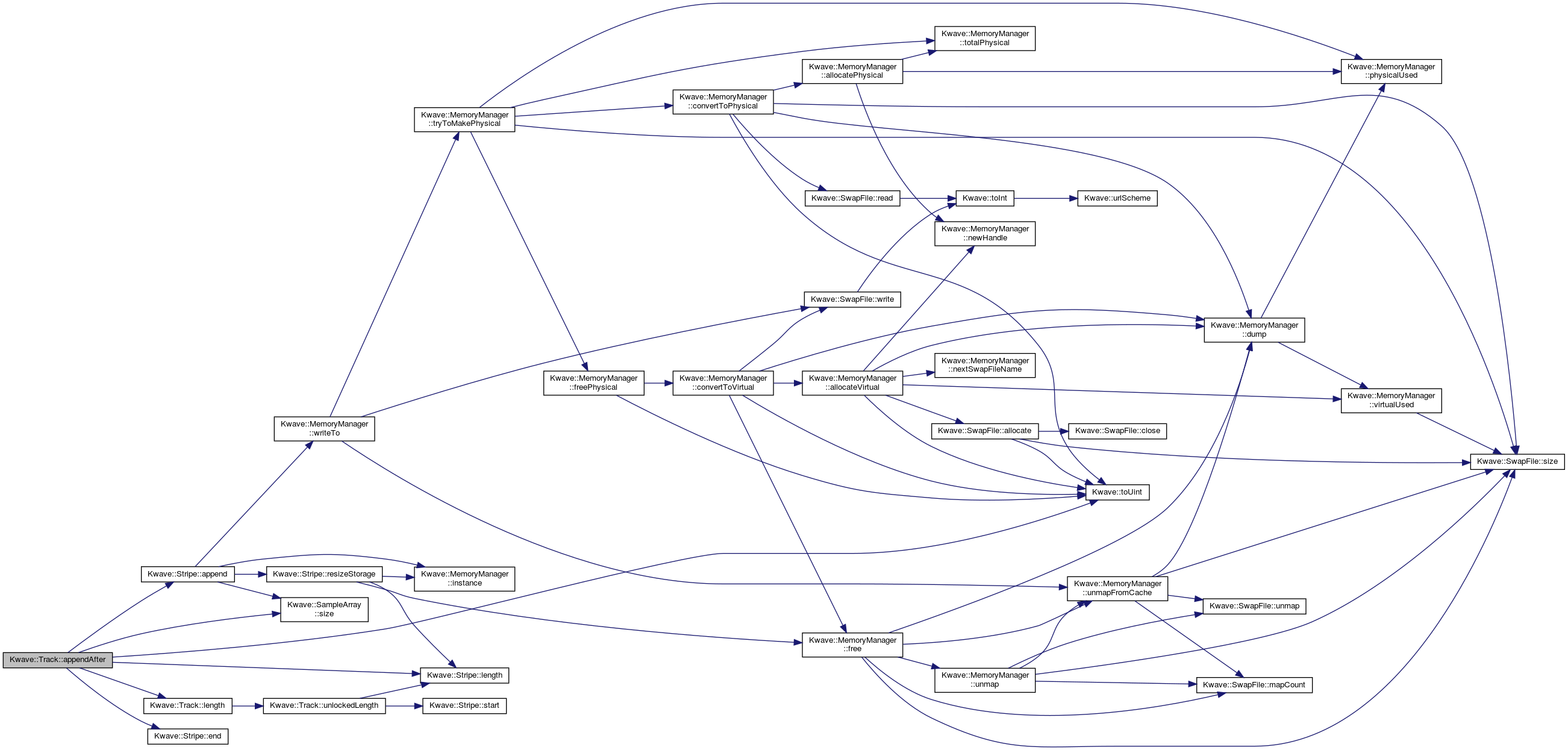

◆ appendStripe()
|
private |
Append a new stripe with a given length.
- Parameters
-
length number of samples, zero is allowed
Definition at line 92 of file Track.cpp.
References m_stripes, Kwave::Stripe::resize(), sigSamplesInserted(), STRIPE_LENGTH_MAXIMUM, Kwave::toUint(), and unlockedLength().
Referenced by Track().


◆ defragment
|
slot |
do some defragmentation of stripes
Definition at line 696 of file Track.cpp.
References Kwave::Stripe::combine(), Kwave::Stripe::end(), Kwave::Stripe::length(), m_lock, m_stripes, Kwave::Stripe::start(), STRIPE_LENGTH_MAXIMUM, STRIPE_LENGTH_MINIMUM, and Kwave::toUint().
Referenced by deleteRange(), mergeStripes(), and openWriter().


◆ deleteRange()
| void Kwave::Track::deleteRange | ( | sample_index_t | offset, |
| sample_index_t | length, | ||
| bool | make_gap = false |
||
| ) |
Deletes a range of samples
- Parameters
-
offset index of the first sample length number of samples make_gap if true, make a gap into the list of stripes instead of moving the stuff from right to left
- Note
- triggers a defragmentation if make_gap is false
Definition at line 293 of file Track.cpp.
References defragment(), m_lock, sigSamplesDeleted(), and unlockedDelete().
Referenced by Kwave::Signal::deleteRange().


◆ dump()
|
private |
dump the list of stripes, for debugging
for debugging only
Definition at line 775 of file Track.cpp.
References Kwave::Stripe::end(), Kwave::Stripe::length(), m_stripes, and Kwave::Stripe::start().

◆ insertSpace()
| bool Kwave::Track::insertSpace | ( | sample_index_t | offset, |
| sample_index_t | shift | ||
| ) |
Inserts space at a given offset by moving all stripes that are are starting at or after the given offset right.
- Parameters
-
offset position after which everything is moved right shift distance of the shift [samples]
- Returns
- true if succeeded, false if failed (OOM?)
Definition at line 314 of file Track.cpp.
References Kwave::Stripe::end(), Kwave::Stripe::length(), m_lock, m_stripes, moveRight(), Kwave::Stripe::resize(), sigSamplesInserted(), splitStripe(), Kwave::Stripe::start(), Kwave::toUint(), and unlockedLength().
Referenced by Kwave::Signal::insertSpace().
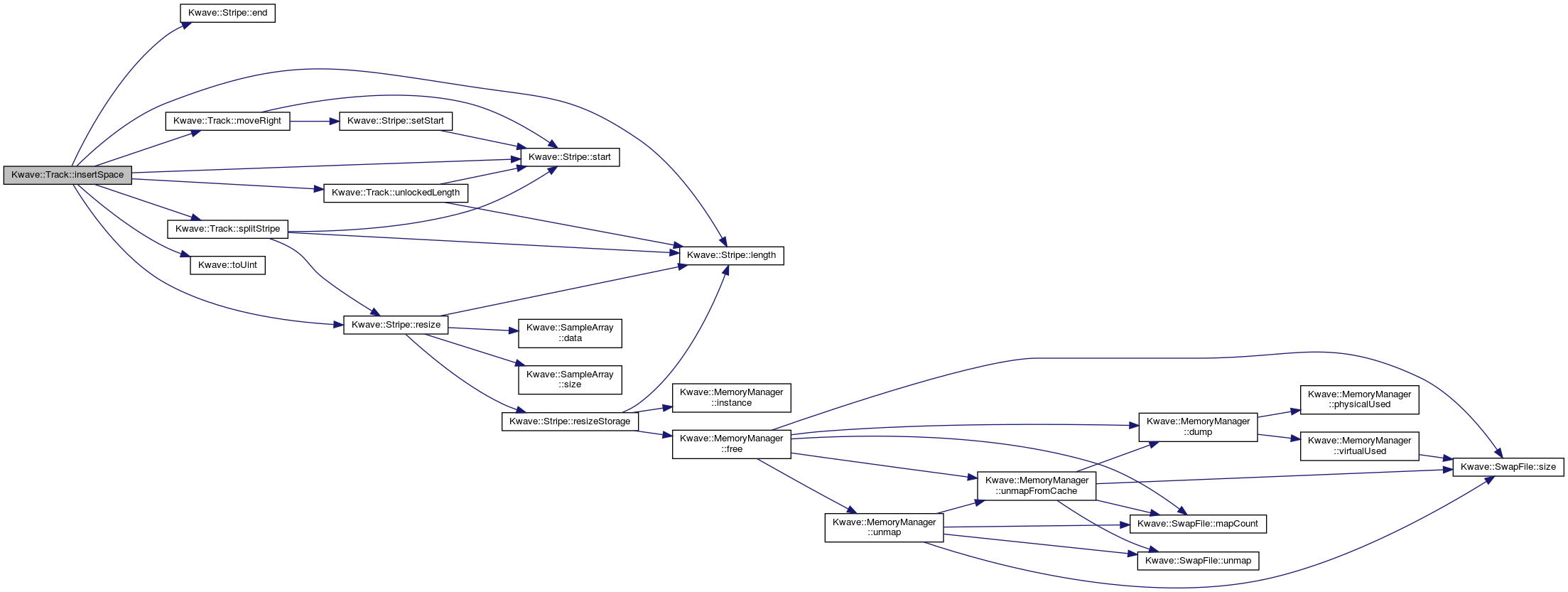

◆ length()
| sample_index_t Kwave::Track::length | ( | ) |
Returns the length of the track. This is equivalent to the position of the last sample of the last Stripe.
Definition at line 173 of file Track.cpp.
References m_lock, and unlockedLength().
Referenced by appendAfter(), Kwave::Signal::length(), Kwave::SignalManager::loadFile(), openReader(), Kwave::TrackPixmap::repaint(), unlockedDelete(), and Kwave::TrackPixmap::validateBuffer().

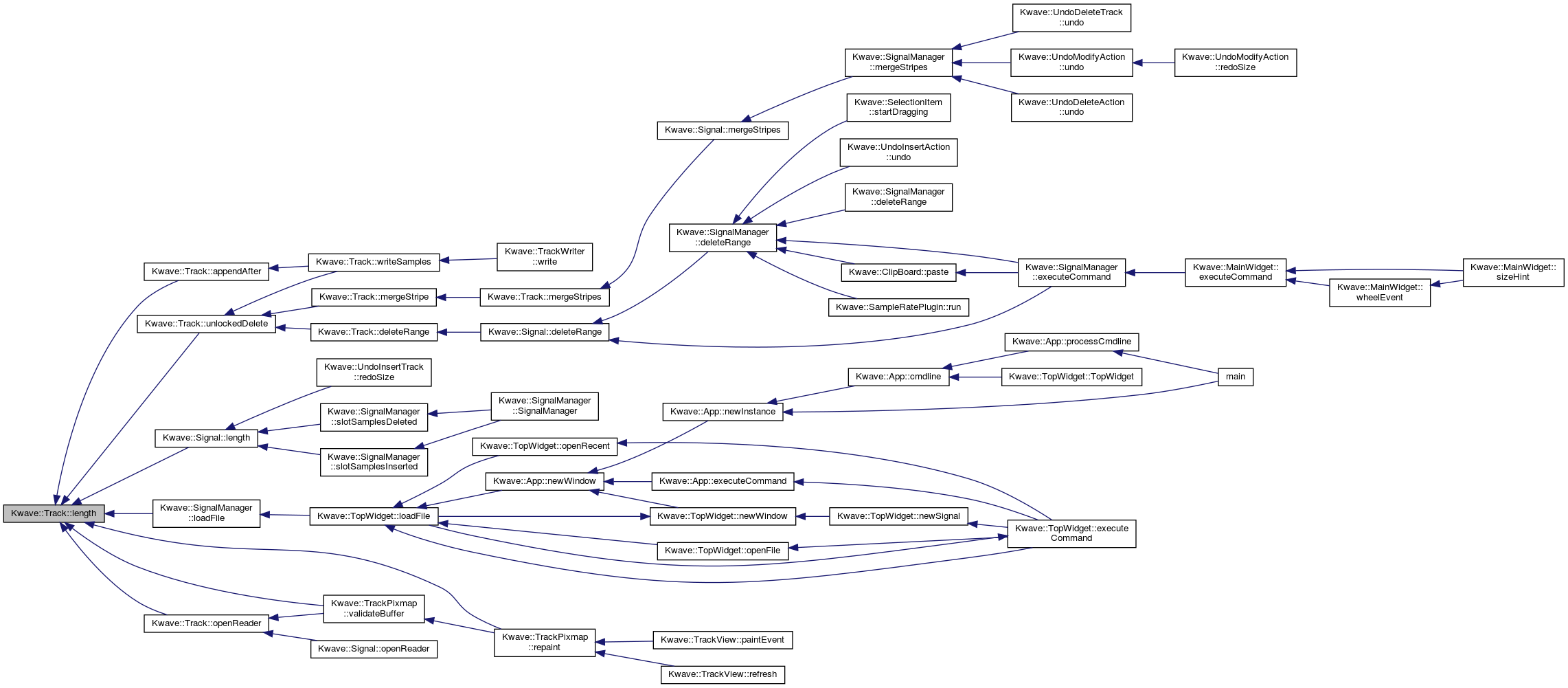
◆ mergeStripe()
|
private |
Merge a single stripe into the track.
- Parameters
-
stripe the stripe to merge
- Returns
- true if succeeded, false if failed
Definition at line 133 of file Track.cpp.
References Kwave::Stripe::end(), m_stripes, Kwave::Stripe::start(), and unlockedDelete().
Referenced by mergeStripes().


◆ mergeStripes()
| bool Kwave::Track::mergeStripes | ( | const Kwave::Stripe::List & | stripes | ) |
Merge a list of stripes into the track.
- Parameters
-
stripes list of stripes
- Returns
- true if succeeded, false if failed
- Note
- triggers a defragmentation
Definition at line 251 of file Track.cpp.
References defragment(), Kwave::Stripe::List::left(), m_lock, mergeStripe(), Kwave::Stripe::List::right(), and sigSamplesModified().
Referenced by Kwave::Signal::mergeStripes().


◆ moveRight()
|
private |
Move all stripes after an offset to the right. Only looks at the start position of the stripes, comparing with ">=", if the start of a stripe is at the given offset, it will not be moved!
- Parameters
-
offset position after which everything is moved right shift distance of the shift [samples]
Definition at line 546 of file Track.cpp.
References m_stripes, Kwave::Stripe::setStart(), and Kwave::Stripe::start().
Referenced by insertSpace(), and writeSamples().


◆ newStripe()
|
private |
Creates a new stripe with a start position and a length.
- Parameters
-
start offset of the first sample length number of samples, zero is allowed
- Note
- this must be private, it does no locking !
◆ openReader()
| Kwave::SampleReader * Kwave::Track::openReader | ( | Kwave::ReaderMode | mode, |
| sample_index_t | left = 0, |
||
| sample_index_t | right = SAMPLE_INDEX_MAX |
||
| ) |
Opens a stream for reading samples. If the last position is omitted, the value UINT_MAX will be used.
- Parameters
-
mode read mode, see Kwave::ReaderMode left first offset to be read (default = 0) right last position to read (default = UINT_MAX)
Definition at line 274 of file Track.cpp.
References length(), m_lock, stripes(), and unlockedLength().
Referenced by Kwave::Signal::openReader(), and Kwave::TrackPixmap::validateBuffer().


◆ openWriter()
| Kwave::Writer * Kwave::Track::openWriter | ( | Kwave::InsertMode | mode, |
| sample_index_t | left = 0, |
||
| sample_index_t | right = 0 |
||
| ) |
Opens a stream for writing samples, starting at a sample position.
- Parameters
-
mode specifies where and how to insert left start of the input (only useful in insert and overwrite mode) right end of the input (only useful with overwrite mode)
- See also
- InsertMode
- Note
- destruction of the writer triggers defragmentation
Definition at line 188 of file Track.cpp.
References Kwave::connect(), and defragment().
Referenced by Kwave::Signal::openWriter().


◆ release()
|
protected |
decrements the usage counter (read lock to m_lock_usage)
Definition at line 769 of file Track.cpp.
References m_lock_usage.
Referenced by Kwave::TrackWriter::~TrackWriter().

◆ select()
| void Kwave::Track::select | ( | bool | select | ) |
Sets the "selected" flag.
Definition at line 464 of file Track.cpp.
References m_selected, selected(), and sigSelectionChanged().
Referenced by toggleSelection().


◆ selected()
|
inline |
Returns the "selected" flag.
Definition at line 137 of file Track.h.
Referenced by Kwave::TrackPixmap::repaint(), select(), toggleSelection(), and Kwave::TrackView::TrackView().

◆ sigSamplesDeleted
|
signal |
Emitted if data has been removed from the track.
- Parameters
-
src source track of the signal (*this) offset position from which the data was removed length number of samples deleted
Referenced by deleteRange().

◆ sigSamplesInserted
|
signal |
Emitted if the track has grown. This implies a modification of the inserted data, so no extra sigSamplesModified is emitted.
- Parameters
-
src source track of the signal (*this) offset position from which the data was inserted length number of samples inserted
- See also
- sigSamplesModified
Referenced by appendStripe(), insertSpace(), and writeSamples().

◆ sigSamplesModified
|
signal |
Emitted if some data within the track has been modified.
- Parameters
-
src source track of the signal (*this) offset position from which the data was modified length number of samples modified
Referenced by mergeStripes(), and writeSamples().

◆ sigSelectionChanged
|
signal |
Emitted whenever the selection of the track has changed.
- Parameters
-
selected true if selected, false if unselected
Referenced by select().

◆ splitStripe()
|
private |
Split a stripe into two stripes. The new stripe will be created from the right portion of the given stripe and the original stripe will be shrinked to it's new size. The newly created stripe will be inserted into m_stripes after the old one.
- Parameters
-
stripe the stripe to be split offset the offset within the stripe, which becomes the first sample in the new stripe
- Returns
- the new created stripe
Definition at line 111 of file Track.cpp.
References Kwave::Stripe::length(), Kwave::Stripe::resize(), and Kwave::Stripe::start().
Referenced by insertSpace(), unlockedDelete(), and writeSamples().


◆ stripes()
| Kwave::Stripe::List Kwave::Track::stripes | ( | sample_index_t | left, |
| sample_index_t | right | ||
| ) |
Get a list of stripes that matches a given range of samples
- Parameters
-
left offset of the first sample right offset of the last sample
- Returns
- a list of stripes that cover the given range between left and right
Definition at line 209 of file Track.cpp.
References Kwave::Stripe::deleteRange(), Kwave::Stripe::end(), Kwave::Stripe::length(), m_lock, m_stripes, Kwave::Stripe::resize(), Kwave::Stripe::setStart(), Kwave::Stripe::start(), and Kwave::toUint().
Referenced by openReader(), and Kwave::Signal::stripes().
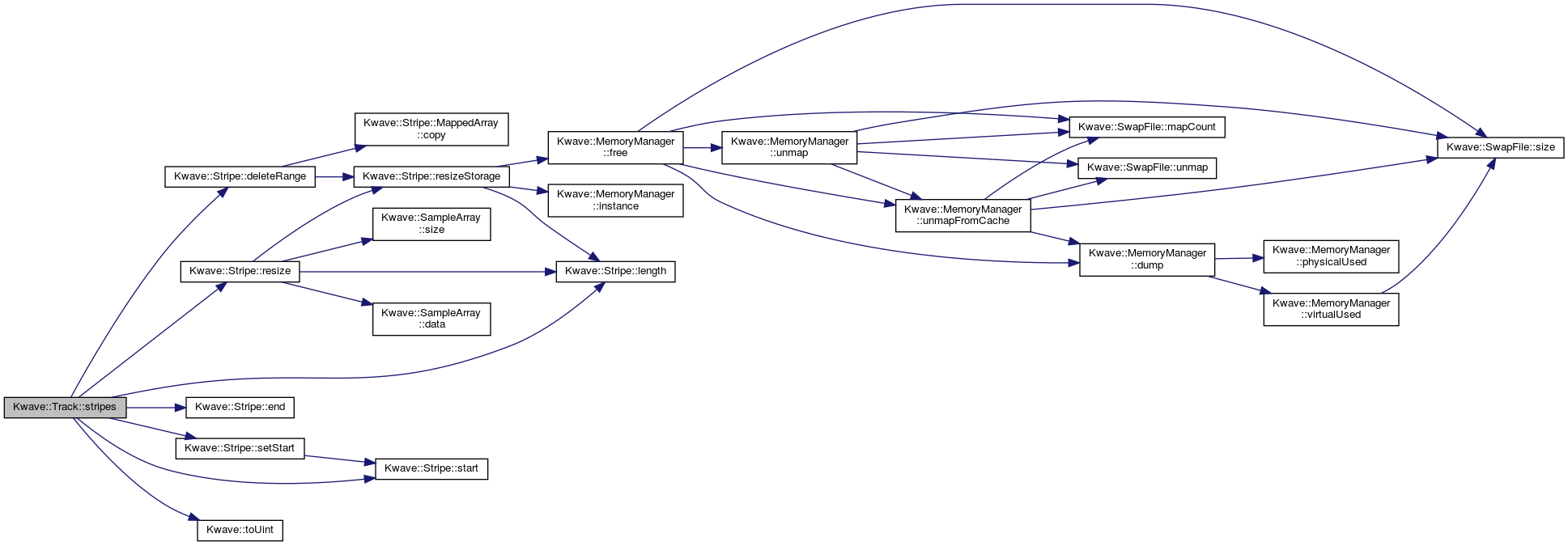

◆ toggleSelection
|
slot |
toggles the selection of the slot on/off
Definition at line 472 of file Track.cpp.
References select(), and selected().

◆ unlockedDelete()
|
private |
Deletes a range of samples, used internally by deleteRange()
- Parameters
-
offset index of the first sample length number of samples make_gap if true, make a gap into the list of stripes instead of moving the stuff from right to left
Definition at line 360 of file Track.cpp.
References Kwave::Stripe::deleteRange(), Kwave::Stripe::end(), length(), Kwave::Stripe::length(), m_stripes, Kwave::Stripe::setStart(), splitStripe(), Kwave::Stripe::start(), and Kwave::toUint().
Referenced by deleteRange(), mergeStripe(), and writeSamples().
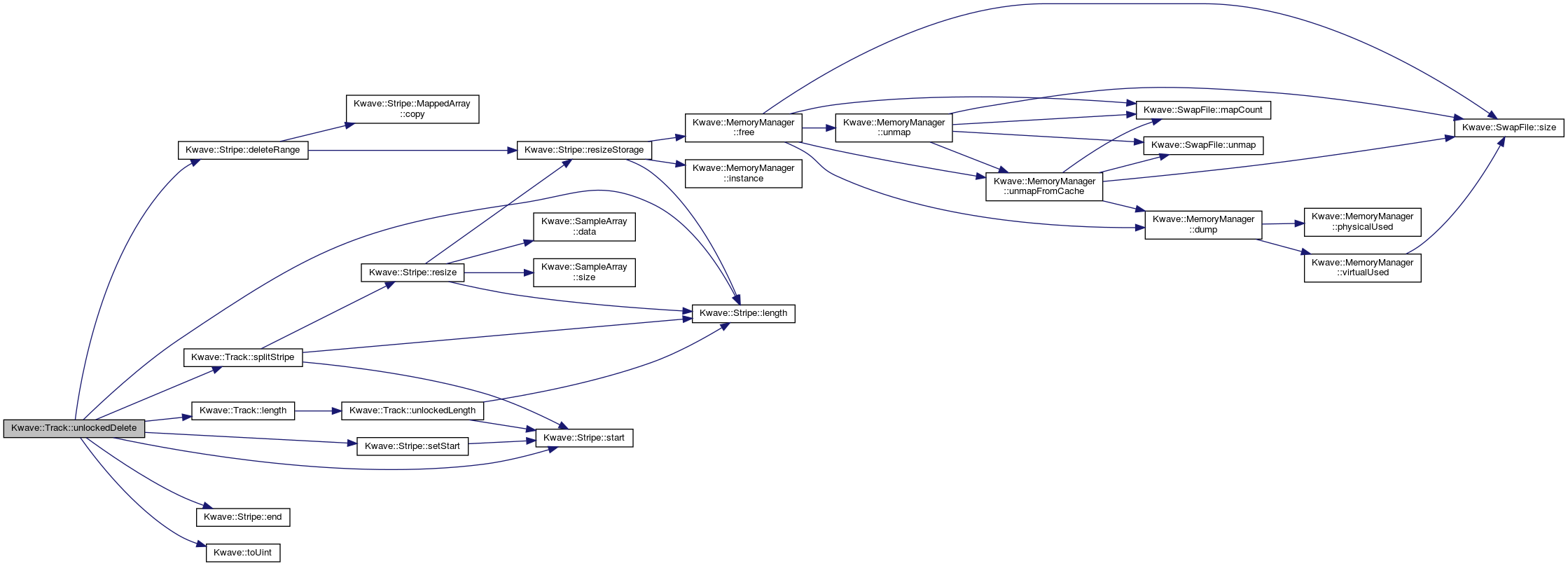

◆ unlockedLength()
|
private |
Returns the current length of the stripe in samples. This function uses no locks and is therefore reserved for internal usage from within locked functions.
- Note
- this must be private, it does no locking !
Definition at line 180 of file Track.cpp.
References Kwave::Stripe::length(), m_stripes, and Kwave::Stripe::start().
Referenced by appendStripe(), insertSpace(), length(), and openReader().

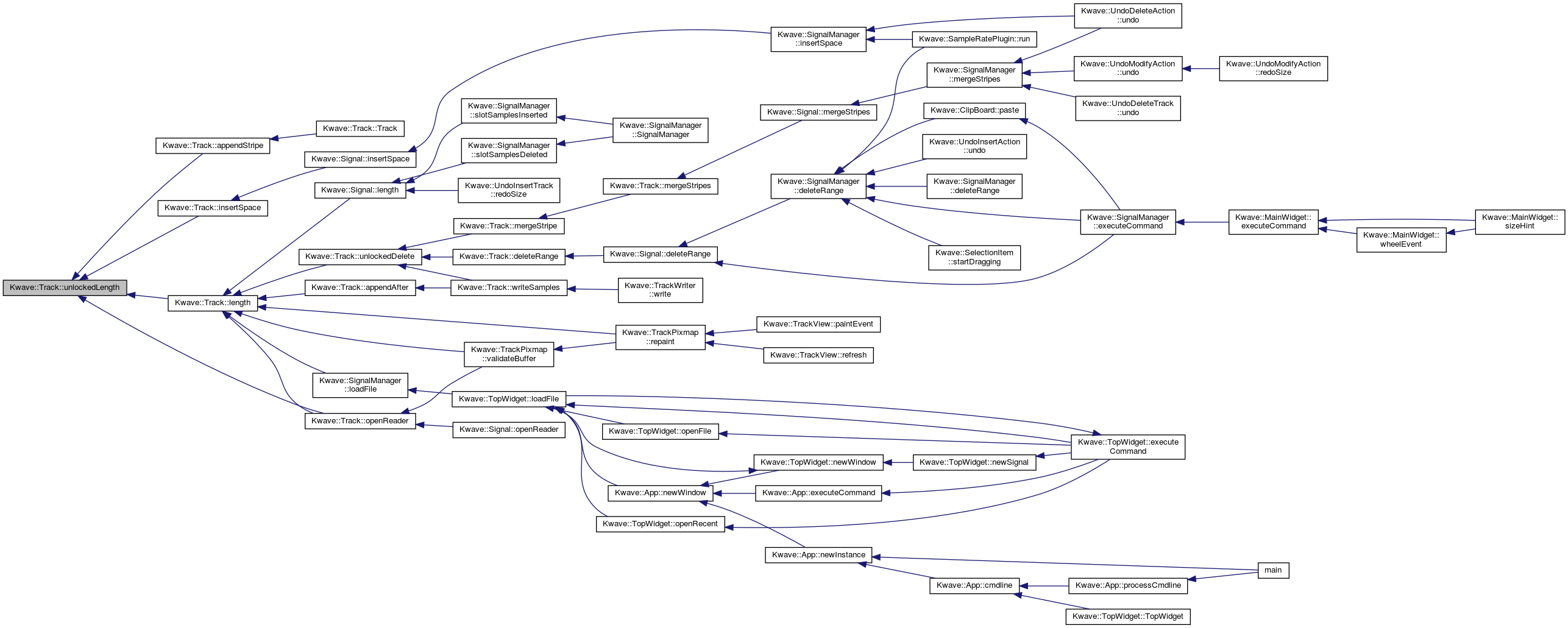
◆ use()
|
protected |
increments the usage counter (read lock to m_lock_usage)
Definition at line 763 of file Track.cpp.
References m_lock_usage.
Referenced by Kwave::TrackWriter::TrackWriter().

◆ uuid()
|
inline |
returns the unique ID of this track instance
Definition at line 143 of file Track.h.
Referenced by Kwave::SelectionTracker::slotTrackDeleted(), and Kwave::SelectionTracker::slotTrackInserted().

◆ writeSamples()
|
protected |
Write a block of samples. If necessary it starts, appends to, or splits a stripe.
- Parameters
-
mode a InsertMode (append/overwrite/insert) offset position where to start the write operation buffer array with samples buf_offset offset within the buffer length number of samples to write
- Returns
- true if successful, false if failed (e.g. out of memory)
Definition at line 561 of file Track.cpp.
References Kwave::Append, appendAfter(), Kwave::Stripe::end(), Kwave::Insert, Kwave::Stripe::length(), m_lock, m_stripes, moveRight(), Kwave::Overwrite, sigSamplesInserted(), sigSamplesModified(), splitStripe(), Kwave::Stripe::start(), Kwave::toUint(), and unlockedDelete().
Referenced by Kwave::TrackWriter::write().


Friends And Related Function Documentation
◆ Kwave::TrackWriter
|
friend |
Member Data Documentation
◆ m_lock
|
private |
lock for access to the whole track
Definition at line 308 of file Track.h.
Referenced by defragment(), deleteRange(), insertSpace(), length(), mergeStripes(), openReader(), stripes(), writeSamples(), and ~Track().
◆ m_lock_usage
|
private |
◆ m_selected
|
private |
◆ m_stripes
|
private |
list of stripes (a track actually is a container for stripes)
Definition at line 314 of file Track.h.
Referenced by appendAfter(), appendStripe(), defragment(), dump(), insertSpace(), mergeStripe(), moveRight(), stripes(), Track(), unlockedDelete(), unlockedLength(), writeSamples(), and ~Track().
◆ m_uuid
The documentation for this class was generated from the following files:
